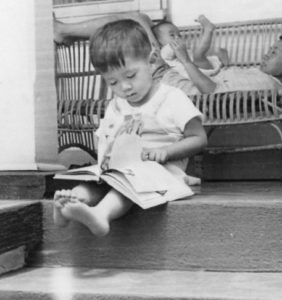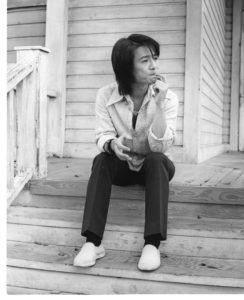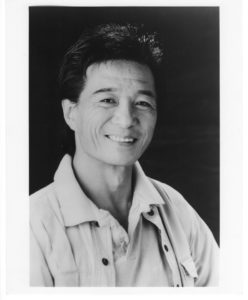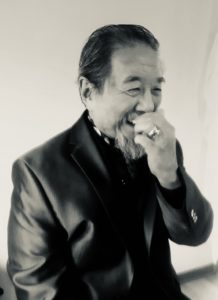This site consists of verbal and pictorial fragments and remnants of a life in the theatre. To give you a fuller idea of who I am, these following paragraphs recall some of the most important influences and inspirations that shaped the very foundation of my life and work.
THE BEGINNING

I was born on a beautiful rock in the middle of the Pacific…when the world was at war. I spent my boyhood on a farm in Hawaii at the foot of an extinct volcano—Koko Head Crater. My closest companion was my imagination and it made me perpetually restless, always hungry for stories—stories told to me, stories overheard, stories sent through the radio or projected onto screens or enacted before my eyes, stories I found in a myriad of books—I was insatiable. At age 10, I saw my first play, Oklahoma at the Honolulu Community Theatre…and it was ecstasy to see that make-believe could be “real.” Then hearing ARSENIC AND OLD LACE over the radio was fortuitously defining my inclination with laughter and leading me to love fine play writing. CYRANO DE BERGERAC on the screen and MACBETH on the television seduced me even further. I was still in high school when the University of Hawaii Drama Department under the inspired leadership of Dr. Earle Ernst instituted a far-sighted program called the Great Plays Cycle, whereby over the course of four years, a student could see performances of eight of the greatest plays in the Western tradition. HAMLET and OEDIPUS REX were a part of that cycle, and I was a 16 year old adolescent witnessing both plays live on-stage for the very first time. I was shaken to the core; nuclear explosions went off in my imagination. I was passionately in love; I would be a stage actor devoted to the “classical” theatre.  The following year, I came to understand the kind of actor I would need to become if I were to fully undertake these plays. It was the summer of 1961 immediately following my high school graduation that I was visiting family in San Diego, California. While walking through Balboa Park, I stumbled upon a reconstruction of Shakespeare’s theatre. San Diego’s Old Globe Theatre was open for business and currently playing: THE MERCHANT OF VENICE, TWELFTH NIGHT, and RICHARD III. I could barely keep my feet on the ground and immediately rushed to buy tickets for all three. The company could not have been better—wonderful, wonderful actors all working in rep in three different plays. One actor, however, harpooned my soul. His name was Morris Carnovsky. I was grossly naïve—I had no idea who he was and I was totally ignorant of his history. I had to see the plays again and immediately bought another round of tickets with the last few shekels in my pocket—I had to make sure that my eyes had not deceived me! Witnessing Mr. Carnovsky’s “Shylock” was…well…I can hardly find the words to describe my experience…for it went way beyond what passes for a good performance. I did not see an actor merely acting. “Shylock” was alive, immediate, tangible, breathing and…simply human. When an actor accomplishes a feat of simple humanity, that is extraordinary. Morris Carnovsky gave me an irrevocable vision and my struggle was now fully defined, my life’s path was now permanently lit.
The following year, I came to understand the kind of actor I would need to become if I were to fully undertake these plays. It was the summer of 1961 immediately following my high school graduation that I was visiting family in San Diego, California. While walking through Balboa Park, I stumbled upon a reconstruction of Shakespeare’s theatre. San Diego’s Old Globe Theatre was open for business and currently playing: THE MERCHANT OF VENICE, TWELFTH NIGHT, and RICHARD III. I could barely keep my feet on the ground and immediately rushed to buy tickets for all three. The company could not have been better—wonderful, wonderful actors all working in rep in three different plays. One actor, however, harpooned my soul. His name was Morris Carnovsky. I was grossly naïve—I had no idea who he was and I was totally ignorant of his history. I had to see the plays again and immediately bought another round of tickets with the last few shekels in my pocket—I had to make sure that my eyes had not deceived me! Witnessing Mr. Carnovsky’s “Shylock” was…well…I can hardly find the words to describe my experience…for it went way beyond what passes for a good performance. I did not see an actor merely acting. “Shylock” was alive, immediate, tangible, breathing and…simply human. When an actor accomplishes a feat of simple humanity, that is extraordinary. Morris Carnovsky gave me an irrevocable vision and my struggle was now fully defined, my life’s path was now permanently lit.
A SEMINAL PERIOD
In my introductory statement, I credited performances of HAMLET and  OEDIPUS REX with kick-starting my now insatiable thirst for “classical” writing and story-telling. I referred to MORRIS CARNOVSKY and his “Shylock” as giving me a vision of the kind of acting needed for such work as well as a strong taste of being a Shakespearian repertory actor. In 1964, a dear friend Charles Bright and I left Hawaii to try our fortunes in New York, America’s most active theatre city. I was in a state of constant bedazzlement. What a pleasure it was for me, a novice, to see two Metropolitan operas in the wonderful old opera house on 39th and Broadway…from the standing-room section just behind the good seats! Wagner’s THE FLYING DUTCHMAN and Puccini’s TURANDOT (with the dashing Franco Corelli as “The Calaf” and the heart-breaking Licia Albanese as “Liu”). GRAND Opera, INDEED! Early in 1965, Charles was taken on as an apprentice with the Association of Producing Artists at the Phoenix on East 74th Street. They were doing three plays in rep: Shaw’s MAN AND SUPERMAN, Giraudoux’s JUDITH, and a fantastic stage adaptation of Tolstoy’s WAR AND PEACE. Charles and I got to know the House Manager and whenever I could (which was quite often) he would let me in to fill some unsold seat. Performance after performance, watching these actors work, this was Paradise. What I witnessed lives in my memory. Sadly I do not recall seeing Ellis Rabb perform, but I did see Rosemary Harris, Sydney Walker, Donald Moffat, Nancy Marchand, Paul Sparer, Christine Pickles, Keene Curtis, Clayton Corzatte, Joanna Roos, Richard Woods, Et Al—perhaps, the warmth of my feeling for these actors came out of the fact that I had seen some of them a few years earlier performing with Mr. Carnovsky in San Diego. At any rate, on returning to Hawaii, there was no shaking the spell they had cast on me feeding to this very day a longing for an American classical repertory company. Between 1966 and 1967 I found myself in London, the other thrilling theatre center in the English-speaking world. I fortunately had a part-time job and spent every shilling on theatre tickets blitzing my imagination with Ralph Richardson’s “Shylock” and “Sir Anthony Absolute,” the Royal Shakespeare Company doing Ibsen’s GHOSTS (with Peggy Ashcroft’s “Mrs. Alving”) and Vanburgh’s THE RELAPSE (with Donald Sinden’s “Lord Foppington”) and the National Theatre of Great Britain (with a company of some of England’s finest actors, including the great Laurence Olivier himself!) performing Feydeau’s A FLEA IN HER EAR, Strindberg’s THE DANCE OF DEATH, Congreve’s LOVE FOR LOVE, Stoppard’s ROSENCRANTZ AND GUILDENSTERN ARE DEAD, Shakespeare’s AS YOU LIKE IT and Chekhov’s THE THREE SISTERS! My God, friends!
OEDIPUS REX with kick-starting my now insatiable thirst for “classical” writing and story-telling. I referred to MORRIS CARNOVSKY and his “Shylock” as giving me a vision of the kind of acting needed for such work as well as a strong taste of being a Shakespearian repertory actor. In 1964, a dear friend Charles Bright and I left Hawaii to try our fortunes in New York, America’s most active theatre city. I was in a state of constant bedazzlement. What a pleasure it was for me, a novice, to see two Metropolitan operas in the wonderful old opera house on 39th and Broadway…from the standing-room section just behind the good seats! Wagner’s THE FLYING DUTCHMAN and Puccini’s TURANDOT (with the dashing Franco Corelli as “The Calaf” and the heart-breaking Licia Albanese as “Liu”). GRAND Opera, INDEED! Early in 1965, Charles was taken on as an apprentice with the Association of Producing Artists at the Phoenix on East 74th Street. They were doing three plays in rep: Shaw’s MAN AND SUPERMAN, Giraudoux’s JUDITH, and a fantastic stage adaptation of Tolstoy’s WAR AND PEACE. Charles and I got to know the House Manager and whenever I could (which was quite often) he would let me in to fill some unsold seat. Performance after performance, watching these actors work, this was Paradise. What I witnessed lives in my memory. Sadly I do not recall seeing Ellis Rabb perform, but I did see Rosemary Harris, Sydney Walker, Donald Moffat, Nancy Marchand, Paul Sparer, Christine Pickles, Keene Curtis, Clayton Corzatte, Joanna Roos, Richard Woods, Et Al—perhaps, the warmth of my feeling for these actors came out of the fact that I had seen some of them a few years earlier performing with Mr. Carnovsky in San Diego. At any rate, on returning to Hawaii, there was no shaking the spell they had cast on me feeding to this very day a longing for an American classical repertory company. Between 1966 and 1967 I found myself in London, the other thrilling theatre center in the English-speaking world. I fortunately had a part-time job and spent every shilling on theatre tickets blitzing my imagination with Ralph Richardson’s “Shylock” and “Sir Anthony Absolute,” the Royal Shakespeare Company doing Ibsen’s GHOSTS (with Peggy Ashcroft’s “Mrs. Alving”) and Vanburgh’s THE RELAPSE (with Donald Sinden’s “Lord Foppington”) and the National Theatre of Great Britain (with a company of some of England’s finest actors, including the great Laurence Olivier himself!) performing Feydeau’s A FLEA IN HER EAR, Strindberg’s THE DANCE OF DEATH, Congreve’s LOVE FOR LOVE, Stoppard’s ROSENCRANTZ AND GUILDENSTERN ARE DEAD, Shakespeare’s AS YOU LIKE IT and Chekhov’s THE THREE SISTERS! My God, friends! When was the last time you saw a theatrical season offering such a roster of playwrights and plays and talent bred for the stage! Forgive me for uttering this flood of names of playwrights, plays and actors—but they are worthy of perpetual remembrance and in my madness, they are life-giving and still able to challenge our imaginations! Immediately upon my return to Hawaii, the Grand Kabuki Theatre of Japan was scheduled to perform two programs of plays. The large company was led by three of its greatest actors: Nakamura Kanzaburo XVII, Onoe Baiko VII, and Ichimura Uzaemon XVII. I had never seen the Kabuki live and I was stunned. Their dedicated effort, disciplined mastery and sublime artistry, all in service to creating a truly popular theatrical entertainment that is exuberant and thrilling, only confirmed what my own efforts had to consist of. There is something extraordinarily special, magical even, about a company of artists who have worked together over a period of time, especially a company dedicated to a classical repertoire. By the age of 25, I knew what kind of theatre enlivened me and I would work to be a part of it.
When was the last time you saw a theatrical season offering such a roster of playwrights and plays and talent bred for the stage! Forgive me for uttering this flood of names of playwrights, plays and actors—but they are worthy of perpetual remembrance and in my madness, they are life-giving and still able to challenge our imaginations! Immediately upon my return to Hawaii, the Grand Kabuki Theatre of Japan was scheduled to perform two programs of plays. The large company was led by three of its greatest actors: Nakamura Kanzaburo XVII, Onoe Baiko VII, and Ichimura Uzaemon XVII. I had never seen the Kabuki live and I was stunned. Their dedicated effort, disciplined mastery and sublime artistry, all in service to creating a truly popular theatrical entertainment that is exuberant and thrilling, only confirmed what my own efforts had to consist of. There is something extraordinarily special, magical even, about a company of artists who have worked together over a period of time, especially a company dedicated to a classical repertoire. By the age of 25, I knew what kind of theatre enlivened me and I would work to be a part of it.
.
.
.
I AM DEEPLY GRATEFUL TO MY WIFE ANNIE OCCHIOGROSSO FOR PUTTING UP WITH ALL THE TIME AND LABOR INVOLVED WITH THE MAKING OF THE SITE AND ITS ALL-CONSUMING ATTENTION ON THE PAST. MERCIFULLY, WE CAN NOW MOVE FORWARD INTO THE WORK OF OUR REMAINING DAYS. I AM DEEPLY GRATEFUL TO NICK BETTENS FOR HIS FRIENDSHIP, HIS ENERGY, RESOURCEFULNESS AND SKILL—THE SITE WOULD NEVER HAVE COME INTO BEING SO COMPLETELY AND SO BEAUTIFULLY.
